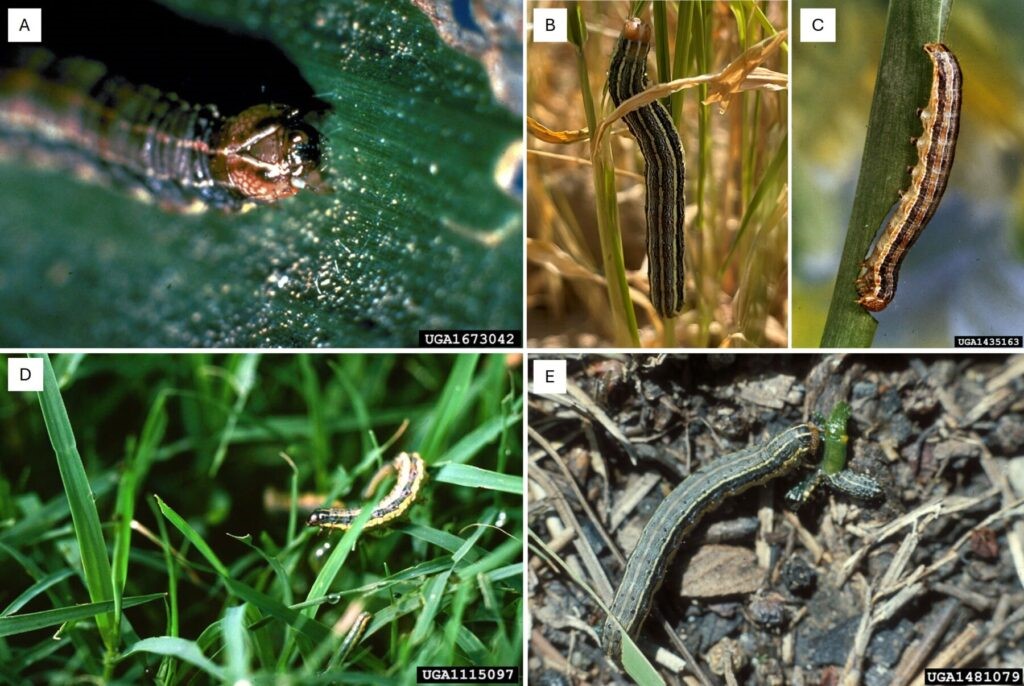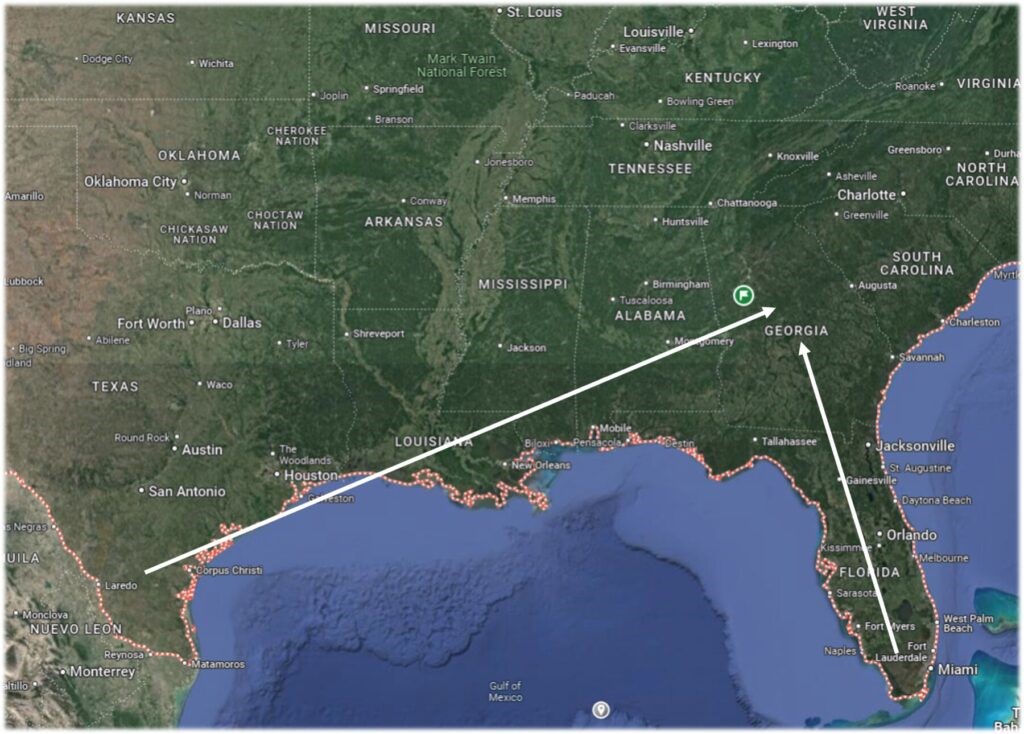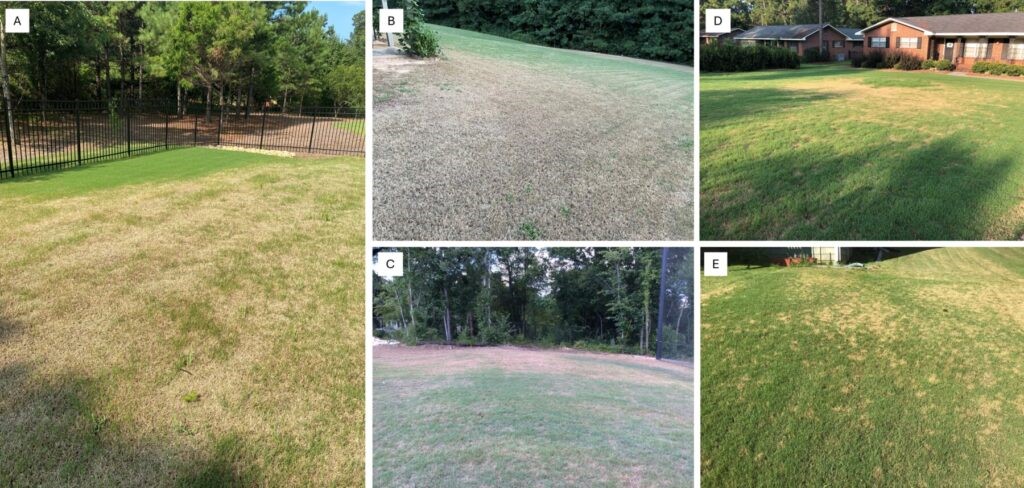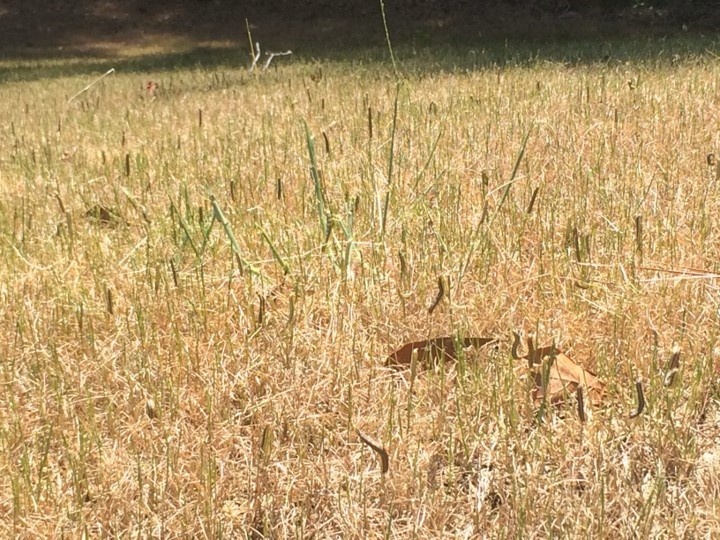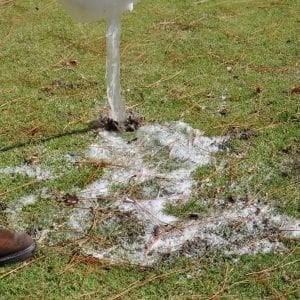Fall armyworm: Biology and Management in Georgia Turfgrass
Written by Shimat V. Joseph
August 18, 2024
The fall armyworm, Spodoptera frugiperda (J. E. Smith) (Fig. 1), is native to North America. Fall armyworm caterpillars are identified with an “inverted Y-shaped” sign on their head capsule (Fig. 1A). Fall armyworms are active throughout the year in the tropical region of Florida (from Tampa to Miami), southern Texas, and northern Mexico. Fall armyworm moths are dispersed yearly from these regions to the northern US states, including Georgia, through weather fronts, such as storms and wind currents (Fig. 2). They reach Georgia in the spring or early summer, and caterpillars are noticed in turfgrass mostly early July. The exact timing of their arrival in Georgia from tropical regions is subject to weather conditions and varies every year (Fig. 3). When weather activity is in certain years, more moths arrive, which causes a high population to begin with. Regardless of when they arrive, they can go through at least two or three generations in Georgia, and their populations will grow rapidly as we pass the summer and fall (Fig. 3). The wet conditions in the summer increase their chances for young, tiny caterpillars to survive better than in drought conditions. However, relatively dry conditions with high temperatures support older caterpillars as they thrive in the summer. By the end of the fall, entire fall armyworm populations in Georgia die as they cannot survive the freezing conditions (Fig. 3).
Fig. 1. Late-stage fall armyworm caterpillar. Photo credits: A, Steve L. Brown, University of Georgia, Bugwood.org; B, Robert Wolverton; C, Clemson University – USDA Cooperative Extension Slide Series , Bugwood.org; D, Charles T. Bryson, USDA Agricultural Research Service, Bugwood.org; and E, Frank Peairs, Colorado State University, Bugwood.org
Fig. 2. Dispersal and introduction of fall armyworm moths via storms and air currents every year from southern Florida and Texas in the late spring and summer. Photo: Google Maps.
Fig. 3. Incidence of fall armyworm problem in Georgia. Fall armyworm moth photo, Robert J. Bauernfeind, Kansas State University, Bugwood.org; illustration, Theresa Villanassery
Lifecycle
The lifecycle of the fall armyworm is illustrated in Fig. 4. The fall armyworm moths are active at night. After mating, they lay eggs in batches (egg mass). A single egg mass consists of 50-200 eggs, and it appears as a cottony, fussy patch (Fig. 5A). For example, if you see ten egg masses near lawns, it means more than approximately 1000 fall armyworm caterpillars are produced infesting the lawn. They can lay eggs on any surface or structure near a lawn, such as a flag, fence, pole, storage shed, barn, exterior wall (of the house), trees along a wood line, and plants (in a garden), patio, etc. (Fig. 5B-E). All eggs in each mass hatch within 2-3 days at about the same time. These tiny caterpillars aggregate for some time where eggs are laid (Fig. 6A), then leave the site using a thin web and land on turfgrass (Fig. 6B). Caterpillars must feed on the grass within a few hours after the egg hatch. Young caterpillars remain inside the turfgrass and feed on grass blades mostly at night. They reach two inches long when they grow into the fourth and fifth caterpillar stages (Fig. 4). Late-stage caterpillars are aggressive feeders and active during the day and nighttime. In the summer, they take 2-3 weeks before pupating. The fifth stage caterpillars drop from leaves on the soil surface, and then they bore into the soil for pupae (Fig. 7). As an inactive and non-feeding stage, dark brown pupae remain in the soil for a little over a week before emerging as moths (Fig. 8). After a week, the new adults mate and start laying eggs again. In the summer of Georgia, a generation (from egg to moth) is completed within four weeks.
Fall armyworm moths can be everywhere in Georgia during the summer. It is considered a sporadic pest because they are introduced every year from Florida and Texas. The timing and intensity of infestation can vary from location to location.
Damage
The third, fourth, and fifth stages of fall armyworm caterpillars are destructive to turfgrass (Fig. 1). The younger stages (1-3 larval stages) are so tiny that it is hard to determine if the turfgrass is infested with fall armyworm. The green turfgrass will gradually turn brown as the caterpillars grow into the third, fourth, and fifth larval stages. The damaged turfgrass may appear diseased or have experienced drought (Fig. 9). Young caterpillars do well with some moisture (via rain), but late-stage caterpillars do well with dry conditions. Often, moths are introduced to Georgia via back-to-back storms, and when the egg masses hatch, it is mostly during moist conditions. Fall armyworm caterpillars tend to do less feeding damage on healthy than unhealthy turfgrass. Proper fertilizer application, regular mowing, and irrigation will help produce healthy turfgrass. Fertilizer with phosphorus will help with a strong root system that can tolerate feeding damage from fall armyworm caterpillars when that occurs.
Usually, the affected turfgrass grows within 3-4 weeks after mild to moderate infestations with fertilization and irrigation, but re-sodding may be required under severe infestations (Fig. 10), where caterpillars feed on the entire stolon (stem) of turfgrass.
Fig. 9. Fall armyworm caterpillar feeding damage on bermudagrass lawns. Photo credits: A, Ryan Hodgson; B, E, Shimat V Joseph; C, Robert Wolverton; D, Brian Schwartz.
Fig. 10. Severe fall armyworm caterpillar infestation. Photo credit: Robert Wolverton
Monitoring
Because the fall armyworm problem recurs yearly from July to September and the incidence is sporadic, it is important to check for the presence of egg masses as an early detection strategy. Check for egg masses on any structure near turfgrass (Fig. 5). No threshold exists to correlate with damage. The more egg masses there are, the more caterpillars there are and the more damage there is. Please act with band applications of insecticides when you see many egg masses.
The second approach is when you see any signs of feeding damage on the turfgrass. The damage is usually initiated in the turfgrass near the edge or border of a structure where eggs are laid (Fig. 5). Drench or pour soap water into the brown turfgrass where you see the damage (Fig. 11). If present, late stages of fall armyworm caterpillars will wiggle out from the turfgrass. Please take immediate action if the damage is due to the fall armyworm feeding, which will reduce further damage to turfgrass.
Fig. 11. Monitoring before or after insecticide application by pouring soapy water on turfgrass. If fall armyworm caterpillars are present, they will emerge from turfgrass on the turfgrass surface. Photo credit: https://www.aces.edu/blog/topics/lawn-garden/controlling-fall-armyworms-on-lawns-and-turf/.
Management
Early detection via monitoring egg masses on structures would indicate fall armyworm activity in an area starting in July in Georgia. At this stage, they are likely young caterpillars (1-3 stage larvae) hiding inside the turfgrass canopy. Band application of insecticides, such as Bacillus thuringiensis subsp. kurstaki around structures (Fig. 4) or pyrethroid insecticides, such as bifenthrin, permethrin, deltamethrin, etc., will help. Predators, especially ants, ground beetles, and earwigs, are abundant in turfgrass. Maintaining turfgrass with minimal insecticide application will help healthy predator populations in turfgrass. Predators are active during nighttime and effective even at high temperatures in Georgia summer. However, the sudden, overwhelming population of fall armyworm infestations in the late summer or fall require insecticide applications. Similarly, parasitoids (tiny hymenopteran wasps or tachinid flies) can parasitize fall armyworm caterpillars, but high infestations make it difficult to catch up.
Once caterpillars increase in size, chlorantraniliprole insecticide might be the best option. Tetraniliprole insecticide is an additional option for golf courses and athletic fields that can effectively reduce fall armyworm caterpillars. Pyrethroid insecticides may not provide adequate control as caterpillars are in the late stages. Insect growth regulator insecticides, such as diflubenzuron, pyriproxyfen, and azadirachtin, could be added along with pyrethroid to improve efficacy because insect growth regulators affect the growth of caterpillars, especially on the second—and third-stage caterpillars. Pouring soapy water regularly on the affected spots in the turfgrass where the applications were made will help you track if the application reduced caterpillar activity. The number of caterpillars emerging from turfgrass should be lower after days of application.
Bermudagrass is a popular turfgrass type in Georgia and is susceptible to fall armyworm caterpillar infestation. Bemudagrass cultivar ‘TifTuf’ can tolerate some attacks than other bermudagrass cultivars as it grows quicker. Fall armyworm caterpillar infestation is lower or limited on zoysiagrass (such as ‘Zeon,’ ‘Emerald,’ and ‘Zenith’) than on bermudagrass or centipedegrass. St. Augustinegrass is also susceptible to fall armyworm infestations.
If new sod is planted, make sure they are regularly monitored using soapy water, and immediate insecticide applications are made as they are more vulnerable to fall armyworm infestation than already established turfgrass. Please refer to the article “Armyworms in Sod” (https://extension.uga.edu/publications/detail.html?number=C1130&title=armyworms-in-sod) if you planted new sod and is infested with fall armyworm caterpillars.
For more specific insecticide recommendations, consult the GA Pest Management Handbook or your local County Extension Agent. Please read the label before using insecticide because the insecticide label is the Law.

